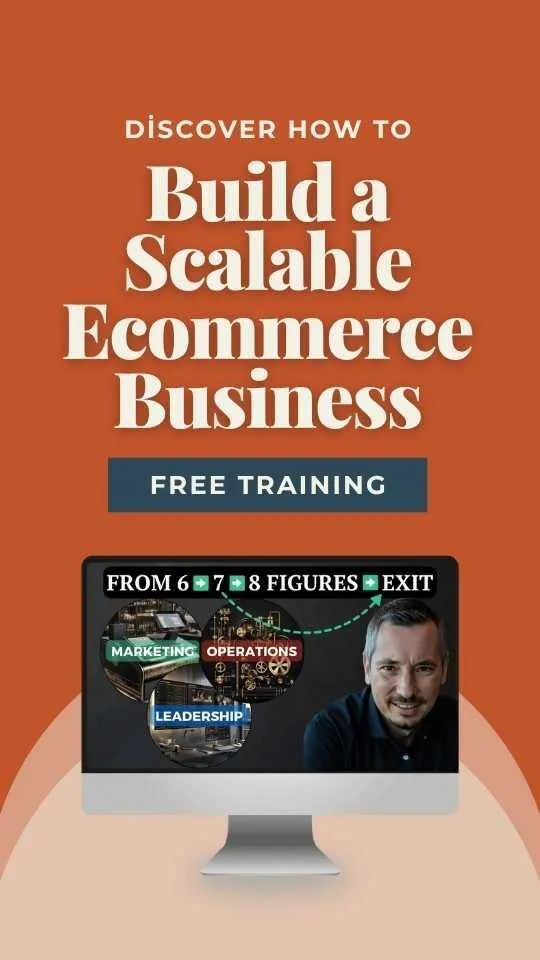What’s Considered a Good ROCE for Your eCommerce Business? Find Out Now!
Running an eCommerce business? You know it's not just about making sales; it's about making smart use of your resources. That's where Return on Capital Employed (ROCE) comes in. A good ROCE for your eCommerce business is typically over 15%. It shows you're using your capital well to generate profits.
Why does ROCE matter? It's like a report card for your business. It tells you if you're getting enough bang for your buck. Better ROCE means you've got a well-oiled machine, pumping out profits efficiently. People today want quick results, so understanding ROCE can give you an edge in this fast-paced market.
Want to boost your ROCE? From analyzing results to improving your strategies, making little adjustments can lead to big profits. Dive into this post, and let’s see how you can sharpen your game and get more cash flowing in.
Key Takeaways
ROCE over 15% is strong for eCommerce.
Understand and analyze ROCE to assess performance.
Improving ROCE can significantly boost profits.
Understanding ROCE
When you're running an eCommerce business, it's crucial to know how efficiently you're using your capital to generate profits. Return on Capital Employed (ROCE) tells you just that. It’s not just about making money, but making your money work hard for you.
Defining ROCE and Its Importance
ROCE stands for Return on Capital Employed. Think of it as a snapshot of how effectively your business is using capital to create profit. The formula is simple: Operating Profit divided by Capital Employed. This ratio helps you see not just if you’re making money, but if your money is working smart.
For eCommerce businesses, a good ROCE signals that your investments in inventory, customer acquisition, and more are paying off. You'll want a higher ROCE because it means you're squeezing more profit from every dollar invested. This metric is essential for showing investors and stakeholders you're utilizing resources efficiently.
ROCE vs Other Profitability Ratios
Now let's put ROCE alongside other profitability ratios like Return on Equity (ROE), Return on Assets (ROA), and Return on Invested Capital (ROIC). Each of these ratios tells a different part of your business story. ROE focuses on shareholder returns, while ROA looks at overall asset efficiency. ROIC digs into the performance of all invested funds.
ROCE gives a broader view by considering both equity and debt. This makes it stand out in evaluating how well a business turns capital into profits. By comparing these ratios, you learn where your business excels and where it might need more attention. Understanding these differences can help you make smarter investment decisions and optimize your eCommerce operations.
Calculating Your ROCE
When you're running an eCommerce biz, knowing if your investment is working is crucial. ROCE helps you see how efficiently your capital is being used. Let’s get into how to calculate it and avoid the usual pitfalls.
Breaking Down the ROCE Formula
So, what's this ROCE formula all about? It’s pretty simple: ROCE = EBIT / Capital Employed. Think about it like this: it's a measure of how well you’re generating profits with the money invested in your business.
EBIT stands for Earnings Before Interest and Tax. This means you're looking at profits before paying interest and taxes. It's like measuring the raw power of your engine before any deductions.
The Capital Employed is your total assets minus current liabilities. In simpler words, it's the long-term funds at your disposal. It includes equity and long-term debt that keep your eCommerce ship sailing smoothly.
Understanding EBIT and Capital Employed
EBIT is your profit before the extras. It helps you see what your core business is pulling in. It’s what you’ve earned from operations—no interest, no taxes involved.
Now, let's chat about Capital Employed. It’s your total assets minus your current liabilities. Total assets mean everything your business owns. Current liabilities? Those are debts or obligations due within a year. Make sure you don’t miss factoring in any long-term debt.
Think of Capital Employed as the money you need to keep your business growing. You need this number right to get your ROCE spot-on.
Common Mistakes in ROCE Calculation
Here’s where folks often trip: they forget full costs in EBIT. Don’t skip out on anything. Even the smallest expense can tweak your results and lead you astray.
Another mix-up happens with Capital Employed. Keep a keen eye on your current liabilities. Missing those can inflate your ROCE or make it look better than it really is.
Watch the timing. ROCE calculations require consistent numbers from the same time period for EBIT and Capital Employed. Mix different periods and you'll end up with unreliable data. Stay sharp and keep your numbers in line.
Analyzing ROCE Results
When you're diving into ROCE, think of it as your business performance scorecard. Understanding how high or low ROCE impacts judgments is key. Industries show different averages, and using it to stack your company against others is crucial for snapping big decisions.
Interpreting High vs. Low ROCE
High ROCE is a winner. It means your business is doing more with less. You're utilizing your capital to make profits happen. Investors love this because it screams efficiency.
A low ROCE? Not so hot. It signals trouble in paradise. Maybe your capital isn’t pulling its weight. Analysts might see risk here.
But don't panic. Look at why it's low. Maybe it's because you’re in a growth phase, spending big to expand fast. Always check the details. High or low, context is king.
ROCE Across Different Industries
Different strokes for different folks, right? What's considered a good ROCE varies. In tech, high ROCEs are more common because of light capital needs. Capital-intensive sectors—like manufacturing—might have lower ROCEs as the norm.
So, what does it mean for you? You can't just compare ROCEs between industries blindly. You’ve got to keep things comparable. Sector comparability is crucial.
Know your industry benchmarks. Use ROCE to see where you stand. Are you above the norm? A rockstar of your industry? Or lagging behind? Get this lockdown for better strategic planning.
Using ROCE to Compare Companies
When comparing companies, ROCE is your trusty sidekick. It helps show who's outperforming whom in similar market conditions. By using ROCE, you judge which company makes the most of its resources.
Focus on companies in the same industry. A retailer's ROCE will look different from a tech firm's. You want to compare apples to apples.
ROCE gives you a straight line to see who’s leading the pack. Investors zero in on efficiency. They want to know which company’s squeezing out the most juice with what they’ve got. It's not just a number; it's a competitive edge.
Improving Your eCommerce ROCE
Increasing your eCommerce Return on Capital Employed (ROCE) is all about making smart, sharp moves. You want higher profits, better efficiency, and wise use of resources. Here's how to do that.
Boosting Efficiency and Profit Margins
First things first: efficiency. You want to do more with less. Cut waste and make sure every dollar works hard. Simplify processes. Automate where you can. Faster processes mean lower costs and better profit margins.
Profit margins matter too. Raise prices if it fits the market. Lower your costs by finding cheaper suppliers. Always look for ways to produce your goods better and cheaper. High-efficiency operations keep money in the bank and pump up your ROCE. It's not about hustling harder—it's about smarter moves.
Strategic Capital Allocation
Your capital needs to work for you, like a well-trained team. Allocate it where the returns are highest. This could mean investing in marketing to boost sales, or maybe developing new products. Don’t throw money at just anything.
Capital allocation is about priorities. Focus on investments that pull in cash and profit. Look at your cash flow. If an investment drains money without solid returns, reconsider. Shifting your resources to better projects can bump your ROCE up. Remember, it's all about making your capital a superstar.
Debt Financing and Its Impact
Debt can be a double-edged sword. It can boost your ROCE if used right, but too much can drag it down. Assess your total debt regularly. Can your cash flow handle it?
Using debt wisely means looking at the cost of debt versus what you earn from it. If debt financing locks in more profit than it costs, you're golden. Manage your weighty debt load. If interest eats up your profits, find ways to pay down faster. Balance matters. Too little debt might mean missed growth. Too much, and your ROCE tanks. Play this card carefully.
Key Considerations Beyond ROCE
When running an eCommerce business, ROCE is crucial, but relying on it alone is risky. Dive into its limitations and explore other financial metrics to get a comprehensive view of your business health. ROCE can't paint the full picture, so let's look at what else matters.
The Limitations of ROCE
ROCE measures profitability but doesn’t tell the whole story. It's a snapshot—just one financial indicator. It doesn't account for the unique challenges of eCommerce like market shifts.
Seasonal businesses might show skewed ROCE. Sudden changes in capital can lead to misleading results. ROCE is great, but it won't tell you about cash flow or market conditions. For holistic assessment, pair it with other metrics.
Other Essential Financial Metrics
Don't just stop at ROCE. Check out Return on Investment (ROI) for insights on specific project gains. Return on Equity (ROE) offers a look at profits generated with shareholder equity. Return on Invested Capital (ROIC) tells you how well a business is using its capital.
Pay attention to working capital, too. It keeps your operations flowing smoothly. These financial ratios together provide a clear picture of financial efficiency.
Holistic Views on Financial Health
Looking only at ROCE means missing out on the bigger picture. You need more than just numbers. Consider growth prospects and corporate performance. How’s the market treating you? Are your strategies working?
Solidify a plan that includes all angles—customer satisfaction, brand strength, and market position. Your eCommerce business thrives when you balance financial data with a clear vision, making sure you're not just planning for today but gearing up for the future too.
Case Studies and Success Stories
ROCE, or Return on Capital Employed, is a big deal in eCommerce. It’s a key player in deciding whether a business thrives or dives. Let’s unpack how successful businesses harness ROCE and how you can too.
Evaluating ROCE in Successful eCommerce
In eCommerce, some businesses have nailed it by focusing on ROCE. They know it isn’t just about raking in revenue; it’s about squeezing more profits from every dollar invested.
You’ve got players like Happy Box, the eCommerce wonder that utilized ROCE to skyrocket growth, boasting a 10x increase. They used ROCE to tweak operations and refine product offerings, aligning investments with core strategies.
High ROCE isn't just about the money; it’s about efficiency. Successful businesses reduce waste, maximize output, and keep an eye on both short-term gain and long-term sustainability.
Learnings from ROCE-Led Investment Decisions
Investment decisions aren’t simple, but ROCE brings clarity. Businesses like Warby Parker have honed in on ROCE for their strategies, ensuring investments are shrewd and aligned with profitability. They’ve shifted funds to boost areas with high returns while pruning those that don’t.
Understanding where to put your money is crucial. With ROCE, you get a compass pointing to optimal cash flow generation.
Businesses see higher returns by refining product lines, slashing unnecessary costs, and focusing on customer-centric innovations. It keeps capital-intensive industries more manageable and profitable.
Adapting ROCE Insights to Your Business Model
Adapting ROCE insights isn’t rocket science. Start small, look at your revenue growth and see where you can cut the fluff. ROCE helps pinpoint weaknesses and strengths in your setup, guiding you to make smarter decisions.
It’s a blueprint for success; use it to streamline processes and align your resources effectively. Adjust your strategies by focusing on ROCE-friendly initiatives, ensuring each action contributes to growth and profits.
Implement routines to regularly assess ROCE metrics, stay agile, and let the numbers direct adjustments. Your goal is to make ROCE a fundamental part of your business toolkit, driving sustainable success.
Tools and Resources for ROCE Analysis
When digging into the nuts and bolts of ROCE, some tools and resources can be real game-changers. Whether using online apps or subscribing to services, you can streamline and sharpen your financial analysis.
Online ROCE Calculators and Apps
You're busy. You don’t have time to crunch numbers all day. That's where ROCE calculators and apps come in handy. These tools are like having a finance whiz in your pocket, doing the heavy lifting.
Many of these calculators let you input metrics like net operating profit after tax (NOPAT) and capital employed. They churn out ROCE values quickly and efficiently. Some apps even have nifty features that track performance over time, showing how changes in cash reserves affect the numbers. You can find free calculators online or go premium for more features. Investing in a good app means you’ll spend less time on spreadsheets and more on strategy.
Subscribing to Analytical Services
If apps aren’t cutting it, professional analytical services can elevate your ROCE analysis game. These subscriptions offer in-depth reports and tools that break down complex metrics. They make good use of metrics like cash reserves and NOPAT.
Services like Bloomberg or Capital IQ give you a snapshot and detailed analysis of industry trends. They also provide benchmarks, so you can compare your business against the competition. While these tools are an investment, they can offer insights that free tools might miss.
Subscribing to an analytical service means you'll have data-driven insights at your fingertips. This will help you make smarter decisions to grow your eCommerce empire.
Summing Up ROCE for Your eCommerce Growth
So, you're aiming for that sweet spot with ROCE? Great. You're looking at maximizing how your capital—like shareholders' equity or invested capital—translates into profits.
More growth means ensuring every dollar you invest works hard. That includes keeping an eye on non-current liabilities and making sure they're working in your favor.
Got intangible assets like trademarks? Don't let them sit idle. They can be a hidden gem for boosting your ROCE.
Everyone wants efficiency. Your job? Make sure your equity and capital do the heavy lifting. A strong ROCE can be the difference between staying afloat and growing big in the eCommerce game.







